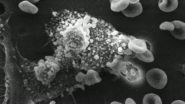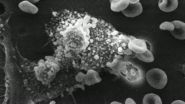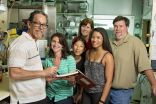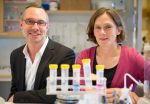(Press-News.org) VIDEO:
Salk scientists find that a vitamin D-derivative makes tumors vulnerable to chemotherapy.
Click here for more information.
LA JOLLA—A synthetic derivative of vitamin D was found by Salk Institute researchers to collapse the barrier of cells shielding pancreatic tumors, making this seemingly impenetrable cancer much more susceptible to therapeutic drugs.
The discovery has led to human trials for pancreatic cancer, even in advance of its publication today in the journal Cell. By attacking a wound repair mechanism called fibrosis, the findings may also have implications for other tough-to-treat tumors, such as lung, kidney and liver cancer.
"While the success of this drug in humans with pancreatic cancer is still unclear, the findings in animal studies were strong, raising hope that ongoing clinical trials will give people with this terrible disease hope for a truly new type of therapy," says Ronald Evans, director of Salk's Gene Expression Laboratory and senior author of the new paper.
Pancreatic cancer is one of the deadliest forms of cancer, a fact highlighted in recent years by the deaths of well-known figures such as Steve Jobs and Patrick Swayze. About 46,000 people are diagnosed in the United States each year and about 40,000 people die from the disease, according to the National Institutes of Health.
"For pancreatic cancer, the five-year survival rate is the lowest of all cancers," says Evans, holder of Salk's March of Dimes Chair and a Howard Hughes Medical Institute investigator. "Part of the problem is that the science of pancreatic cancer and its renowned resistance to therapy has not been understood and that's why the work that we're doing is so important."
Evans and his colleagues knew that the ability of the pancreatic tumor to communicate with nearby cells—called the tumor microenvironment—is key to its growth. Tumor cells send out signals that make the microenvironment inflamed and dense; this "living shield" around a tumor not only helps the cancer grow, but blocks the access of immune cells and chemotherapeutic drugs, making the cancer particularly hard to treat.
Evans—in collaboration with researchers around the country involved in an interdisciplinary initiative supported by Stand Up to Cancer—wanted to figure out how to restore this inflamed microenvironment to its normal or "quiescent" state and weaken the wall around the tumor.
"There was evidence that the activation of the microenvironment was theoretically reversible, but nobody knew exactly what was responsible for the activation, making it hard to turn off," says Salk postdoctoral research fellow Mara Sherman, first author of the new paper.
Sherman, Evans and their collaborators focused their attention on one component of this wall: pancreatic stellate cells, which usually respond to small injuries by briefly switching to an activated state, spurring new cell growth. In the case of cancer, however, the stellate cells near a tumor—in response to signals from the tumor—are constantly turned on. This chronic activation of the stellate cells provides the tumor cells with extra growth factors and therefore helps them proliferate, but also forms a wall-like barrier around the tumor that protects it from chemotherapeutics and other cancer-fighting drugs.
In 2013, Evans' group discovered that stellate cells in the liver could be inactivated by a chemically modified form of vitamin D. They wondered whether the same could hold true in the pancreas, despite the fact the vitamin D receptor was not thought to be present in pancreatic tissue.
But indeed, when the group of researchers examined the differences between activated and inactivated stellate cells in the pancreas, they found that activated stellate cells near a tumor had high levels of the vitamin D receptor. And when the researchers then added modified vitamin D to activated stellate cells the cells quickly reverted back to a healthy, inactivated state, stopping production of signals that spur growth and inflammation.
"This was a big surprise because vitamin D has been tried multiple times as a therapy for pancreatic cancer and never worked," says Evans.
It turns out that activated stellate cells rapidly break down normal vitamin D, preventing the vitamin from binding to the receptor, Evans explains. But systematic analysis of vitamin D analogues allowed the team to discover a modified form of vitamin D that is more stable, resilient and effective in vitro.
To see whether this new vitamin D-like compound could halt the growth of a tumor, Evans and the team next studied its effectiveness in mice. The researchers found that combining the drug with existing chemotherapeutics gave a 50 percent increase in lifespan compared to chemotherapy alone.
"It's really remarkable considering that vitamin D itself is not attacking the cancer cells," says Michael Downes, a senior staff scientist at Salk and co-corresponding author of the new work. "It's changing the environment to a more favorable setting needed for the chemotherapy drugs to work."
Studies have shown that people deficient in vitamin D are more likely to develop pancreatic cancer. Based on the new results, Evans thinks that healthy levels of vitamin D may help keep vitamin D receptor signaling in stellate cells normal and squash a cancer's growth—at least until a tumor itself forces the stellate cells to "turn on."
"Recently, other research groups have explored the idea of destroying the microenvironment altogether to weaken a tumor," says Downes. "Our approach is very different. Instead of destroying, we simply want to reprogram the tumor microenvironment to a healthy state. This has the dual effects of delivering more drugs to the tumor as well as replenishing the tissue with normal stellate cells."
VIDEO:
Salk scientists find that a vitamin D-derivative makes tumors vulnerable to chemotherapy.
Click here for more information.
Evans group has already teamed up with clinicians at the University of Pennsylvania to launch a clinical trial testing the effectiveness of using their vitamin D-like drug in cancer patients before pancreatic surgery. "Previous trials with vitamin D failed because they didn't understand the need for a special form of vitamin D and that for pancreatic cancer it must be used in combination with chemotoxic drugs," Evans says. "So, by re-thinking the problem, have been able to open up a new route to the treatment of pancreatic cancer and, looking forward, hopefully other diseases as well."
INFORMATION:
Other researchers on the study were Ruth T. Yu, Ning Ding, Annette R. Atkins, Tiffany W. Tseng, Geoffrey M. Wahl, and Tony Hunter of the Salk Institute for Biological Studies; Dannielle D. Engle, Herve Tiriac, and David A. Tuveson of Cold Spring Harbor Laboratory; Eric A. Collisson of the University of California, San Francisco; Frances Connor of Cancer Research UK; Terry Van Dyke of NCI-Frederick; Serguei Kozlov and Philip Martin of Leidos Biomed, Inc.; David W. Dawson and Timothy R. Donahue of University of California, Los Angeles; Atsushi Masamune and Tooru Shimosegawa of Tohooku University; Minoti V. Apte and Jeremy S. Wilson of University of New South Wales; Beverly Ng, Sue Lynn Lau, and Jenny Gunton of the Garvan Institute of Medical Research; Jeffrey A. Drebin and Peter J. O'Dwyer of the University of Pennsylvania; and Christopher Liddle of the University of Sydney.
The work was supported by a Ruth L. Kirchstein National Research Service Award, grants from the National Institutes of Health, the Leona M. and Harry B. Helmsley Charitable Trust, the IPSEN Foundation, and the Samuel Waxman Cancer Research Foundation. Additionally, individual researchers receive funding from a Stand Up to Cancer Dream Team Translational Cancer Research Grant, the Medical Research Council of Australia, the Cancer Council of New South Wales, the Japan Society for the Promotion of Science, the Howard Hughes Medical Institute and The Lustgarten Foundation.
About the Salk Institute for Biological Studies:
The Salk Institute for Biological Studies is one of the world's preeminent basic research institutions, where internationally renowned faculty probes fundamental life science questions in a unique, collaborative and creative environment. Focused both on discovery and on mentoring future generations of researchers, Salk scientists make groundbreaking contributions to our understanding of cancer, aging, Alzheimer's, diabetes and infectious diseases by studying neuroscience, genetics, cell and plant biology, and related disciplines. Faculty achievements have been recognized with numerous honors, including Nobel Prizes and memberships in the National Academy of Sciences. Founded in 1960 by polio vaccine pioneer Jonas Salk, M.D., the Institute is an independent nonprofit organization and architectural landmark.
Modified vitamin D shows promise as treatment for pancreatic cancer
Salk scientists find that a vitamin D-derivative makes tumors vulnerable to chemotherapy.
2014-09-25
ELSE PRESS RELEASES FROM THIS DATE:
How physical exercise protects the brain from stress-induced depression
2014-09-25
Physical exercise has many beneficial effects on human health, including the protection from stress-induced depression. However, until now the mechanisms that mediate this protective effect have been unknown. In a new study in mice, researchers at Karolinska Institutet in Sweden show that exercise training induces changes in skeletal muscle that can purge the blood of a substance that accumulates during stress, and is harmful to the brain. The study is being published in the prestigious journal Cell.
"In neurobiological terms, we actually still don't know what depression ...
Brain chemical potential new hope in controlling Tourette Syndrome tics
2014-09-25
A chemical in the brain plays a vital role in controlling the involuntary movements and vocal tics associated with Tourette Syndrome (TS), a new study has shown.
The research by psychologists at The University of Nottingham, published in the latest edition of the journal Current Biology, could offer a potential new target for the development of more effective treatments to suppress these unwanted symptoms.
The study, led by PhD student Amelia Draper under the supervision of Professor Stephen Jackson, found that higher levels of a neurochemical called GABA in a part ...
Super enhancers in the inflamed endothelium
2014-09-25
Boston, MA – Normally, the lining of blood vessels, or endothelium, when at rest, acts like Teflon, ignoring the many cells and other factors rushing by in the bloodstream. In response to inflammatory signals, as well as other stimuli, endothelial cells change suddenly and dramatically—sending out beacons to attract inflammatory cells, changing their surface so those cells can stick and enter tissues, and initiating a complex cascade of responses essential to fighting infection and dealing with injury. Unfortunately, these same endothelial responses also promote atherosclerosis, ...
Novel compound prevents metastasis of multiple myeloma in mouse studies
2014-09-25
BOSTON –– In an advance against the problem of cancer metastasis, Dana-Farber Cancer Institute scientists have shown that a specially developed compound can impede multiple myeloma from spreading to the bones in mice. The findings, published in the Sept. 25 issue of Cell Reports, suggest the technique can protect human patients, as well, from one of the most deadly aspects of cancer.
The research involves a new approach to the challenge of cancer metastasis, the process by which tumors spread to and colonize distant parts of the body. Whereas research has traditionally ...
Dinosaur family tree gives fresh insight into rapid rise of birds
2014-09-25
The most comprehensive family tree of meat-eating dinosaurs ever created is enabling scientists to discover key details of how birds evolved from them.
The study has shown that the familiar anatomical features of birds – such as feathers, wings and wishbones – all first evolved piecemeal in their dinosaur ancestors over tens of millions of years.
However, once a fully functioning bird body shape was complete, an evolutionary explosion began, causing a rapid increase in the rate at which birds evolved. This led eventually to the thousands of avian species that we know ...
Strategic or random? How the brain chooses
2014-09-25
Many of the choices we make are informed by experiences we've had in the past. But occasionally we're better off abandoning those lessons and exploring a new situation unfettered by past experiences. Scientists at the Howard Hughes Medical Institute's Janelia Research Campus have shown that the brain can temporarily disconnect information about past experience from decision-making circuits, thereby triggering random behavior.
In the study, rats playing a game for a food reward usually acted strategically, but switched to random behavior when they confronted a particularly ...
New protein players found in key disease-related metabolic pathway
2014-09-25
CAMBRIDGE, Mass. (September 25, 2014) – To coordinate their size and growth with current environmental conditions, cells rely on the mechanistic target of rapamycin complex 1 (mTORC1) pathway, which senses cellular stresses, growth factors, and the availability of nutrients, such as amino acids and glucose.
For years, Whitehead Institute Member David Sabatini and his lab have been teasing apart the numerous proteins involved in this vital metabolic pathway, in part because mTORC1 function is known to be deregulated in a variety of diseases, including diabetes, epilepsy, ...
Large study pinpoints synapse genes with major roles in severe childhood epilepsies
2014-09-25
An international research team has identified gene mutations causing severe, difficult-to-treat forms of childhood epilepsy. Many of the mutations disrupt functioning in the synapse, the highly dynamic junction at which nerve cells communicate with one another.
"This research represents a paradigm shift in epilepsy research, giving us a new target on which to focus treatment strategies," said pediatric neurologist Dennis Dlugos, M.D., director of the Pediatric Regional Epilepsy Program at The Children's Hospital of Philadelphia, and a study co-author. "There is tremendous ...
Protein controlling gut's protective force field identified
2014-09-25
Scientists have identified a protein in the human intestine that helps to protect against attack from opportunistic bacteria that strike when our defences are down. The protein receptor is activated during illness, producing a force field on the gut's surface made of a sugary substance that encourages the growth of protective bacteria.
Scientists deleted the IL-22RA1 gene that produces the receptor protein from the mouse genome. In the absence of this gene, which is associated with inflammatory bowel disease (IBD) in humans, the mice were found to be more susceptible ...
NYU Langone scientists identify key factor that maintains stem cell identity
2014-09-25
NEW YORK, September 25, 2014— A protein implicated in several cancers appears to play a pivotal role in keeping stem cells in an immature "pluripotent" state, according to a new study by NYU Langone Medical Center scientists. The study is published online today in Cell Reports.
Stem cells are the perpetual adolescents of the cellular world, uncommitted to any cell fate. In principle, they can be programmed to differentiate into any mature cell type, holding the promise of regenerating tissues and organs. A fuller understanding of their biology, however, is needed. ...
LAST 30 PRESS RELEASES:
Global first: New Indigenous-led research initiative to revitalize legal orders
Transforming acoustic waves with a chip
When climate risk hits home, people listen: Study reveals key to engagement with disaster preparedness messaging
Major breakthrough against diabetes thanks to a microbial molecule that disarms inflammation
Silicon chips on the brain: Researchers announce a new generation of brain-computer interface
Getting rest is the best
Towards sustainable organic synthesis – Mechanochemistry replaces lithium with sodium in organic reactions
Wireless device ‘speaks’ to the brain with light
Greenhouse gases to intensify extreme flooding in the Central Himalayas
New study sheds light on Milky Way's mysterious chemical history
Could altering the daily timing of immunotherapy improve survival in people with cancer?
Weaving secondary battery electrodes with fibers and tying them like ropes for both durability and performance
Using social media may impair children’s attention
Science briefing: An update on GLP-1 drugs for obesity
Lower doses of immunotherapy for skin cancer give better results
Why didn’t the senior citizen cross the road? Slower crossings may help people with reduced mobility
ASH 2025: Study suggests that a virtual program focusing on diet and exercise can help reduce side effects of lymphoma treatment
A sound defense: Noisy pupae puff away potential predators
Azacitidine–venetoclax combination outperforms standard care in acute myeloid leukemia patients eligible for intensive chemotherapy
Adding epcoritamab to standard second-line therapy improves follicular lymphoma outcomes
New findings support a chemo-free approach for treating Ph+ ALL
Non-covalent btki pirtobrutinib shows promise as frontline therapy for CLL/SLL
University of Cincinnati experts present research at annual hematology event
ASH 2025: Antibody therapy eradicates traces of multiple myeloma in preliminary trial
ASH 2025: AI uncovers how DNA architecture failures trigger blood cancer
ASH 2025: New study shows that patients can safely receive stem cell transplants from mismatched, unrelated donors
Protective regimen allows successful stem cell transplant even without close genetic match between donor and recipient
Continuous and fixed-duration treatments result in similar outcomes for CLL
Measurable residual disease shows strong potential as an early indicator of survival in patients with acute myeloid leukemia
Chemotherapy and radiation are comparable as pre-transplant conditioning for patients with b-acute lymphoblastic leukemia who have no measurable residual disease
[Press-News.org] Modified vitamin D shows promise as treatment for pancreatic cancerSalk scientists find that a vitamin D-derivative makes tumors vulnerable to chemotherapy.





